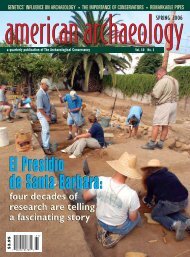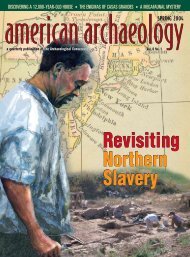Clovis Comet Debate - The Archaeological Conservancy
Clovis Comet Debate - The Archaeological Conservancy
Clovis Comet Debate - The Archaeological Conservancy
You also want an ePaper? Increase the reach of your titles
YUMPU automatically turns print PDFs into web optimized ePapers that Google loves.
liz lopez<br />
<strong>The</strong> convento at Gran Quivira. <strong>The</strong> area surrounded by the square wall in the center was once a pen where livestock were kept.<br />
While investigating the Spanish Colonial-period walled<br />
gardens, agricultural fields, and corrals at Abó, Quarai, and<br />
Gran Quivira, Morrow confirmed historical accounts of Old<br />
World crops such as peaches, apricots, grapes, and other<br />
fruits, cabbage, peas, cereal grains, and livestock such as donkeys,<br />
horses, cattle, pigs, sheep, and goats. North America’s<br />
earliest wheat fields and the region’s first apple orchards<br />
were introduced by the early 17th-century Franciscans.<br />
Other Spanish Colonial landscape features identified at the<br />
sites include the priests’ patios, waiting rooms, courtyards,<br />
and a walled pond with irrigation ditches.<br />
“<strong>The</strong> Pueblo people had a large series of gardens along<br />
hilltops, slopes, and valleys—not in big two-acre plots like<br />
the Spanish, who grew newly-introduced, cold-tolerant winter<br />
wheat,” says Morrow. “Another big difference was the<br />
Spanish introduction of animal husbandry, with their herds<br />
of cattle, horses, pigs, donkeys, and chickens.”<br />
Widespread drought resulted in famine for much of<br />
New Mexico by the late 1660s, especially eastern areas<br />
such as the Salinas that were most vulnerable to increasing<br />
Apache raids. Spanish documents from this period tell us<br />
that during the winter of 1668, 480 people died of starvation<br />
and disease at Gran Quivira alone, and the remaining<br />
residents fled to Abó in 1671. In 1673, Abó was abandoned,<br />
and four years later the 200 families and resident priest<br />
remaining at Quarai were forced to flee north to Tajique<br />
Pueblo, and then on to Isleta Pueblo, seeking refuge from<br />
the raids. All of the Salinas area pueblos were abandoned<br />
prior to the Pueblo Revolt of 1680, the residents having<br />
joined Tiwa neighbors at Sandia and Isleta Pueblos and<br />
other settlements around what is now El Paso, Texas.<br />
About 130 years later Hispanic villages were established<br />
among the Pueblo and Spanish Colonial ruins at Abó and<br />
Quarai, creating new landscape features that included town<br />
walls, small plazas, a stone lookout tower, new orchards and<br />
fields, an expanded irrigation system, and sheepfolds. <strong>The</strong><br />
descendants of the Sisneros family, mid-19th century settlers<br />
of the area, still live at the site of Abó today.<br />
“<strong>The</strong>se landscapes form an integral part of the development<br />
of the settlements and help to explain the uses of the<br />
sites since occupation began there several hundred years<br />
ago,” Morrow wrote in one of his reports. “I think of myself<br />
as a student of these old gardens, which don’t teach all their<br />
lessons at once. One can’t be 20th-century impatient to<br />
understand these ancient landscapes.”<br />
His findings at the Salinas Mission Pueblos complement<br />
the archaeological and historical records, identifying<br />
differing environmental and cultural adaptations and showing<br />
clear differences in how northern Tewa and southern<br />
Tiwa and Piro Puebloan peoples designed and built their<br />
landscapes, with northern communities such as those of<br />
the Chama Valley and Jemez Mountains heavily relying on<br />
extensive gravel-mulched stone grid gardens, and those in<br />
the Salinas country to the south creating shrub-hollow, berry,<br />
and pocket gardens. “<strong>The</strong>se regional trends,” Morrow says,<br />
“once we recognize them, can give us a better sense of place<br />
and help us to interpret and preserve the landscape.”<br />
Tamara Stewart is the assistant editor of American Archaeology and the<br />
<strong>Conservancy</strong>’s Southwest region projects coordinator.<br />
american archaeology 25




